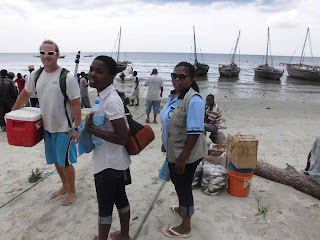June
20th
Today is our first fishing day! After an early breakfast followed by picking
up some fruit for our day on the water, we made our way towards the beach to find
bait. The tide was flooding in so all
the fishing boats could reach their near shore moorings and allow the fisherman
to come ashore. They were all displaying
their catches on the beach in hopes of attracting a buyer and small ‘fish
auctions’ were going on all over the beach.
Mukama, being from Tanzania, acted as our liaison for a lot of our
dealings with the locals and helped us organize some fresh kingfish (mackerel)
and queenfish (trevally) at the market. We also
spotted a young bull shark (less than 1 meter) caught earlier by fishermen… we
loaded our boat and got underway with our hopes high!!!
We did two 50 hook sets in the downstream portion of
the river… but no sharks. We caught three
catfish (Arius africanus) and a large
mud crab. As in the Everglades, our
baits were most likely eaten by scavengers.
The other half of our team was land-based today and
conducted an assessment of vegetation along the downstream portion of the
river. We continued to record birds and also saw our first monkeys along the
shore, confirming that we are NOT in the Everglades!!!
June
21st – 28th
During the last week of our trip we fished
in as many locations as we could, making sure to hit all the areas in and
around the Ruvu River estuary. We fished
in freshwater upstream areas all the way out to the offshore coral reefs. Although we had some great encounters with
hippos, Nile crocodiles, blue monkeys, and yellow baboons, we still only caught
a few more catfish. Even when we fished
in the coral reef habitat… nothing. We
didn’t even see fish swimming around. It
is also interesting to note that during our entire time on the waters in and
around the Ruvu, we didn’t observe any dolphins, sea turtles, sharks, or
schooling fish. Artisanal fishing may
be a big player here, however, more standardized fishing will be needed to say
for sure.
In the last few days, the tides were really
against us for getting on the water. We were
experiencing spring tides with ranges up to 4m and in Bagamoyo that means very
little water at and around low tide.
During these times it wasn’t possible to get our boat off the trailer or
get into the Ruvu River even if we could have launched the boat. We took advantage of this time and visited
the local fisherman on the beach to try and get another look at their hauls to
get a better understanding of the local fish communities… and some
samples!!! After a bit of wheeling and
dealing by Tanzanian fish biologist, Mukama, we had more fish than
we had room for.
Our time was running out quickly, but we
knew the importance of getting as many of these fish sampled as possible. We took them back to the Downtown Bagamoyo
guest house where we were staying and got to work. Each fish was identified to species, weighed,
measured, and sampled for fin and epaxial white muscle. It was a big team effort but after two
straight days of processing fish, we had samples from over 250 individuals and
35 different species. We also managed to
attract every fly within the area and reinforced the utility of the electric
tennis racket bug zapper!!
On the last day of our official business in
Tanzania, we travelled west to Morogoro on a formal invitation from Vivienne
Abbot, the director of the Republic of Tanzania’s Integrated Water Sanitation
and Hygiene program (iWash) and part of a larger Global Water for
Sustainability (GLOWS) program. We
briefed her on the field excursion and plans for moving forward were discussed,
including the possibility of more collaborations with FIU biologists and
personnel! It seems the Tanzania
adventure may not be over yet!!! Asante
sana Tanzania… it has been an esteemed pleasure!!!


















No comments:
Post a Comment